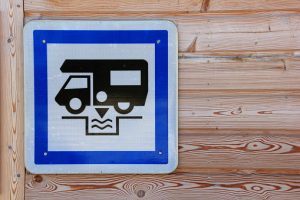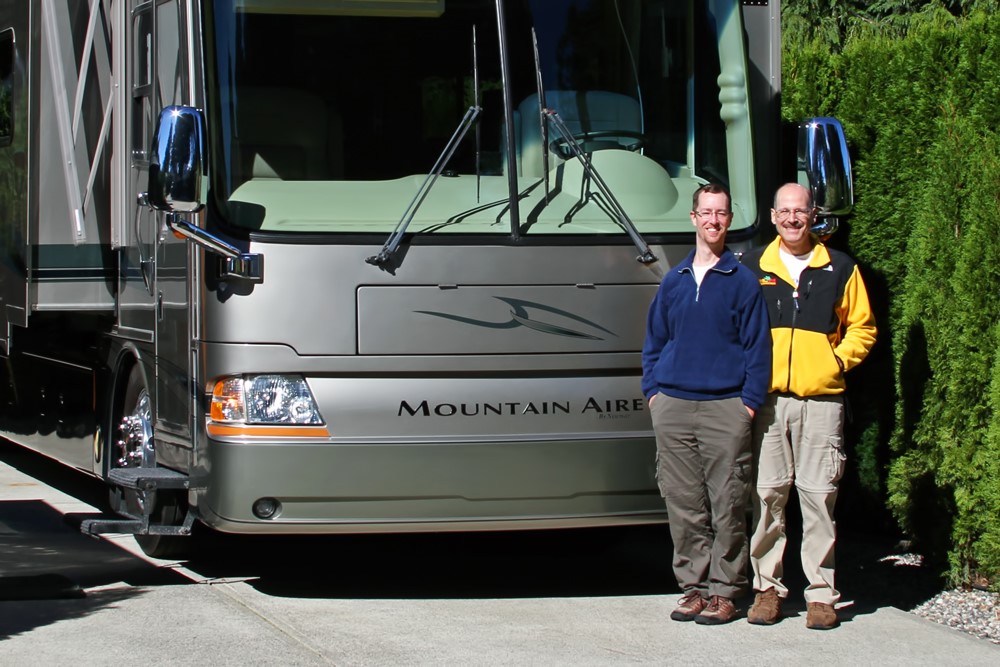
 One of our favorite things about RVing is the wide range of places it allows us to experience. Whether we’re in a luxury RV resort, camping off the grid in the wilderness, or spending a night in a Walmart parking lot, we enjoy all the comforts of home. We prepare and clean up after meals, have our own private bathroom, take showers, and sleep comfortably in our own bed. It’s very freeing, without much sacrifice. A big part of that freedom to travel and stay just about anywhere in comfort is due to the fact that we carry our own fresh water supply, as well as the waste tanks needed to hold that water after it goes down the sink, shower drains, or toilet.
One of our favorite things about RVing is the wide range of places it allows us to experience. Whether we’re in a luxury RV resort, camping off the grid in the wilderness, or spending a night in a Walmart parking lot, we enjoy all the comforts of home. We prepare and clean up after meals, have our own private bathroom, take showers, and sleep comfortably in our own bed. It’s very freeing, without much sacrifice. A big part of that freedom to travel and stay just about anywhere in comfort is due to the fact that we carry our own fresh water supply, as well as the waste tanks needed to hold that water after it goes down the sink, shower drains, or toilet.

As with many RV systems, some basic tips and regular maintenance procedures are needed to help keep everything flowing smoothly. There’s nothing difficult involved, but knowing the basics can help make your time on the road a lot more enjoyable.
Fresh Water
With the fresh water tank, it’s easy to assume that all you have to do is hook up to a potable (drinkable) water supply and fill it up. And actually, most of the time that’s all that’s needed. But if you’re like us, you’d prefer to avoid the waste, effort, expense, and space required to buy, haul and store bottled water, and actually drink the water out of your fresh tank. It does seem a shame to have all that water on board but not be able to drink it.
But how safe is it to drink from the tank? Perfectly safe… if you sanitize the tank periodically. We sanitize about twice a year, and we’ve been safely drinking from our RV’s onboard water supply for more than 15 years. It’s a fairly simple process of mixing some ordinary household bleach with water. Using a ratio of 1/4 cup of bleach for every 15 gallons of fresh tank capacity, add the bleach, fill the tank with water, run some of the chlorinated water up through all of the faucets in the RV, then leave it for at least a few hours or overnight. Then drain the fresh tank, flush it, run the faucets with fresh water, and you’re all set.
To see our step-by-step tutorial video on sanitizing the fresh water system, you can watch it here.
If you’re still concerned about drinking the water on your RV and want some really high-level peace of mind, you might want to consider a system like the Acuva Eco. We installed one last year and love the fact that our drinking water is purified using an ultraviolet LED light, the same method many major cities use to treat municipal water supplies.
Now we don’t worry about sanitizing the tank as often, and we have more confidence than ever in the safety of the water we drink. Not only did we make a video about installing our Eco, but we’re so happy with it that we arranged for Acuva to offer a $100 discount to our viewers! Video and discount details are available here.
Gray & Black Water
For wastewater, the primary goal is minimizing the potential for odors.
Let’s start with the simpler of the two: the gray tank, which collects water from the sink and shower drains. While you’d think that that water would be mostly odor free, guess again! Soap residue, body oils, and food waste from washing dishes and preparing meals can build up. This is especially true when you’re dry camping because the ratio of food, soap, and oily residue to water is much higher when you’re being extra vigilant about conserving water.
Then when you’re driving, the water in the p-traps under your sinks can slosh out, allowing those odors to find their way into your RV’s interior (it’s the water in the traps that blocks odors from coming up).
How you can help
If tank odor becomes a problem
Or if you’ve just bought a used RV that wasn’t cared for as meticulously as you had hoped), you’re going to want to clean things out. Try filling the tank with fresh, clean water and adding a water softener like baking soda, Borax, or Calgon and letting it soak for a couple of days. This can help to soften up anything that’s stuck to the sides or bottom of the tank. For more stubborn odors, you can also add a cup of dishwasher detergent (Purchase the kind for automatic machines, not normal dish soap for sinks. You don’t want anything that foams up!). We made a video about that, which you can find here. There are also plenty of tank treatment products on the market. We avoid those that are just perfumes designed to mask the odor and instead use bacteriological/enzymatic products.
Odors are caused by anaerobic bacteria (bacteria that don’t need oxygen to survive), so using products that help tip the balance toward aerobic (oxygen-consuming) processes minimizes odors.
You also want to be sure that your tank is vented properly
This way air flows up and out through the plumbing vents on the roof, not up through the drains and into your RV. Checking for obstructions in the vent pipe (wasps nests or spider webs) is the first step. Even better, replace the standard vent pipe caps that RV manufacturers use with one that actually promotes the flow of air up and out of the tank, like a 360 Siphon Vent.
Last, but certainly not least, is the black (toilet) tank. Properly maintained, you will likely never smell anything from your black tank. Manage it improperly, and it can accost your nose with an unpleasant bouquet. There are a number of things you’ll want to do.
Keeping things healthy down there
Never, NEVER use the toilet with the black tank drain valve open.
Even when staying at a campsite with full hookups (electric/water/sewer). RV toilets do not operate like household toilets, and your black tank is not like regular sewer plumbing. If you leave the black tank drain valve open, all of the “liquids” will flow out, leaving the “solids” behind. This can result in what is commonly known as “pyramiding”. Due to the shape of the mass that will begin to accumulate. Unlike the ones in Egypt, this is not a pyramid ANYONE wants to see or smell. Leaving the black tank drain valve open at a full hook-up campsite is probably the most notorious self-inflicted wound an RVer can experience. The results can be horrific, and the fix can be expensive. It can even require the services of a professional to unplug the situation.
Don’t put anything down the toilet that isn’t toilet paper… or didn’t come out of you.
You don’t have to suffer from the expensive, poor-quality toilet paper that’s sold at RV supply stores. We’ve always used Kirkland (Costco) brand and have never had a clogged black tank. The trick is to test your favorite toilet paper to see how easily it breaks down. Check out this brand test video.
Avoid dumping the black tank if it isn’t at least half full.
You want good flushing action when dumping to ensure that solid waste gets carried out with the liquid. We also recommend using your built-in tank flush system each and every time you dump. If you don’t have one, a flush wand that you stick down into the toilet can have the same effect.
For a “window” into the health of your black tank, always use a clear elbow on your sewer hose.
You may prefer to avoid watching the contents of your black tank as it drains. Without being able to see it, you won’t have any idea when the tank is properly flushed. You want to rinse the black tank thoroughly enough that the water runs clear. It may sound gross, but trust us, you’ll be much happier in the long run if you watch it drain. And if you only dump in full hook-up campsites where your drain hose adapter is securely screwed into the sewer opening (versus at a dump station), you’ll almost never smell a thing. Dumping is only gross or smelly when done improperly.
Dump the black tank first and the gray tank second.
Although it’s one of the first things most RVers learn, it bears repeating. That way, the black water will get flushed out of the sewer hose by the gray water. It’s just more sanitary that way.
Treat the tank properly.
Again, there are tons of options on store shelves for black tank treatments. We used the RV version of Rid-X for years and lately have been using Happy Campers. They’re both bacteriological, and we like them both. If you’re having odor issues, you can soak the tank with water softener and/or dishwasher detergent to try and clear up the tank floor and walls. Also, Happy Campers Xtreme Clean is designed to break down serious build-ups.
Keep a couple of inches of water in your toilet bowl at all times.
That water barrier is the primary seal against black tank odor. If your toilet seat won’t hold water, it could be due to toilet paper or other debris that’s keeping it from sealing properly. Clean it thoroughly but carefully with a toilet brush, or replace it if that doesn’t work. A toilet with no water in the bowl is the single fastest way to make the whole RV smell bad.
New RVers need guidance,
If you have guests on board who’ve never RVed before, you’ll want to instruct them on the finer points of RV toilet operation. You can either have “The RV Toilet Talk” with them or allow us to do it for you.
A more detailed video about dumping and cleaning the black tank can be found here.
These are simple steps to better enjoy your time on the road, and steer clear of some easy-to-avoid pitfalls. The tips we’ve outlined will quickly become the standard operating procedure, allowing you to relax and enjoy your rig without concern, whether you’re hooked up or not. You’ll be drinking the water from your fresh tank and managing wastewater like a pro in no time!
Tech Tips from The RVgeeks
With 125,000 subscribers and more than 30 million views, Peter & John, better known as The RVgeeks, host one of YouTube’s most popular channels about RVing. Their DIY and how-to videos focus on RV systems, maintenance, driving, repairs, upgrades, destinations and more. As full-timers for more than 15 years, they’re eager to share what they’ve learned along the way. While they aren’t RV technicians, they’re very mechanically inclined, creative problem solvers, and excellent teachers. Their goal is to help fellow RVers go DIY. This saves them time and money while experiencing the satisfaction of a job well done. With their professional presentation and attention to detail, Peter & John set the benchmark for the proper care and feeding of an RV! Visit The RVgeeks website and YouTube channel.


Leave a Reply